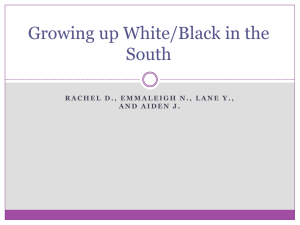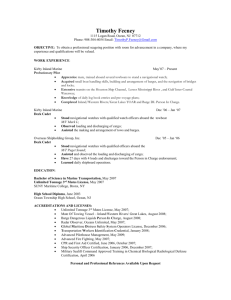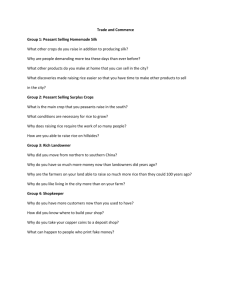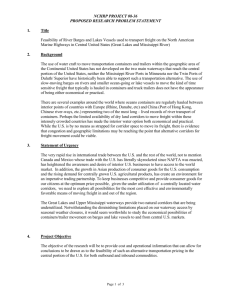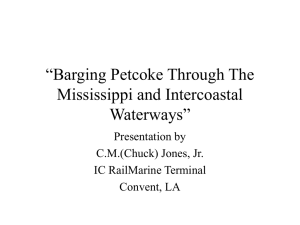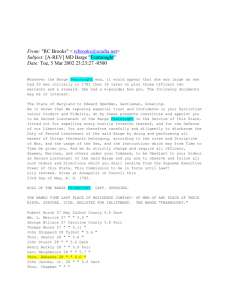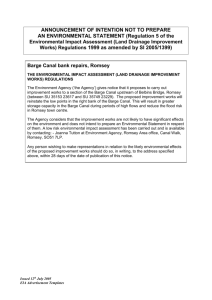Circuit Court of Appeals, Second Circuit. THE T. J. HOOPER. THE
advertisement
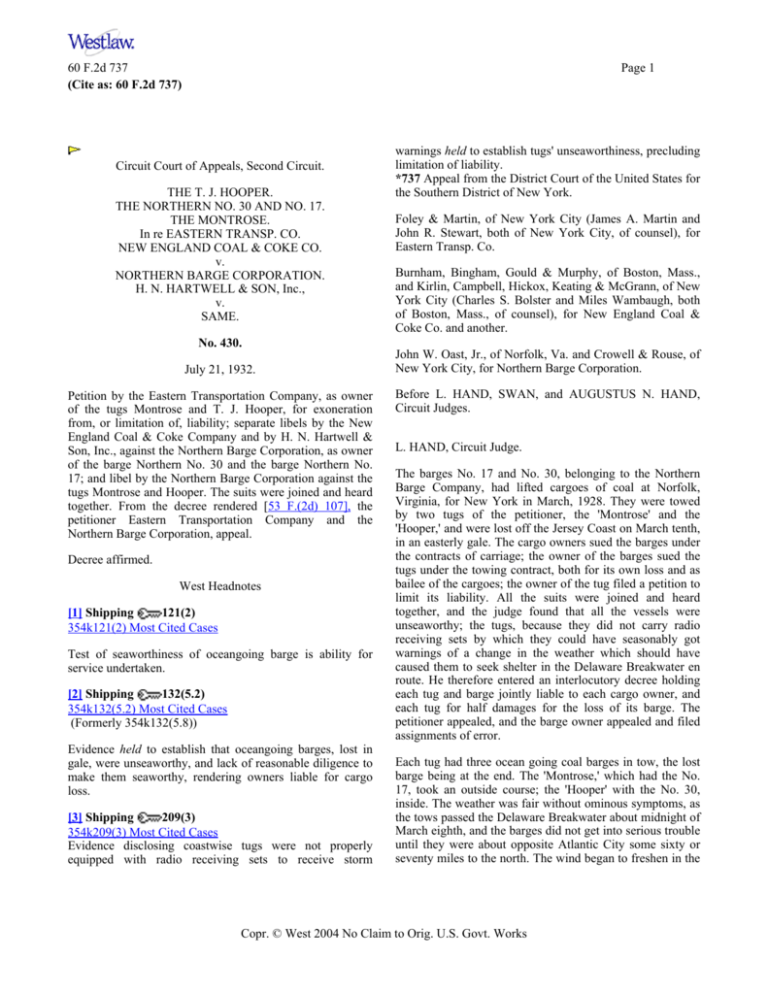
60 F.2d 737 (Cite as: 60 F.2d 737) Page 1 Circuit Court of Appeals, Second Circuit. THE T. J. HOOPER. THE NORTHERN NO. 30 AND NO. 17. THE MONTROSE. In re EASTERN TRANSP. CO. NEW ENGLAND COAL & COKE CO. v. NORTHERN BARGE CORPORATION. H. N. HARTWELL & SON, Inc., v. SAME. No. 430. July 21, 1932. Petition by the Eastern Transportation Company, as owner of the tugs Montrose and T. J. Hooper, for exoneration from, or limitation of, liability; separate libels by the New England Coal & Coke Company and by H. N. Hartwell & Son, Inc., against the Northern Barge Corporation, as owner of the barge Northern No. 30 and the barge Northern No. 17; and libel by the Northern Barge Corporation against the tugs Montrose and Hooper. The suits were joined and heard together. From the decree rendered [53 F.(2d) 107], the petitioner Eastern Transportation Company and the Northern Barge Corporation, appeal. Decree affirmed. West Headnotes [1] Shipping 121(2) 354k121(2) Most Cited Cases Test of seaworthiness of oceangoing barge is ability for service undertaken. [2] Shipping 132(5.2) 354k132(5.2) Most Cited Cases (Formerly 354k132(5.8)) Evidence held to establish that oceangoing barges, lost in gale, were unseaworthy, and lack of reasonable diligence to make them seaworthy, rendering owners liable for cargo loss. [3] Shipping 209(3) 354k209(3) Most Cited Cases Evidence disclosing coastwise tugs were not properly equipped with radio receiving sets to receive storm warnings held to establish tugs' unseaworthiness, precluding limitation of liability. *737 Appeal from the District Court of the United States for the Southern District of New York. Foley & Martin, of New York City (James A. Martin and John R. Stewart, both of New York City, of counsel), for Eastern Transp. Co. Burnham, Bingham, Gould & Murphy, of Boston, Mass., and Kirlin, Campbell, Hickox, Keating & McGrann, of New York City (Charles S. Bolster and Miles Wambaugh, both of Boston, Mass., of counsel), for New England Coal & Coke Co. and another. John W. Oast, Jr., of Norfolk, Va. and Crowell & Rouse, of New York City, for Northern Barge Corporation. Before L. HAND, SWAN, and AUGUSTUS N. HAND, Circuit Judges. L. HAND, Circuit Judge. The barges No. 17 and No. 30, belonging to the Northern Barge Company, had lifted cargoes of coal at Norfolk, Virginia, for New York in March, 1928. They were towed by two tugs of the petitioner, the 'Montrose' and the 'Hooper,' and were lost off the Jersey Coast on March tenth, in an easterly gale. The cargo owners sued the barges under the contracts of carriage; the owner of the barges sued the tugs under the towing contract, both for its own loss and as bailee of the cargoes; the owner of the tug filed a petition to limit its liability. All the suits were joined and heard together, and the judge found that all the vessels were unseaworthy; the tugs, because they did not carry radio receiving sets by which they could have seasonably got warnings of a change in the weather which should have caused them to seek shelter in the Delaware Breakwater en route. He therefore entered an interlocutory decree holding each tug and barge jointly liable to each cargo owner, and each tug for half damages for the loss of its barge. The petitioner appealed, and the barge owner appealed and filed assignments of error. Each tug had three ocean going coal barges in tow, the lost barge being at the end. The 'Montrose,' which had the No. 17, took an outside course; the 'Hooper' with the No. 30, inside. The weather was fair without ominous symptoms, as the tows passed the Delaware Breakwater about midnight of March eighth, and the barges did not get into serious trouble until they were about opposite Atlantic City some sixty or seventy miles to the north. The wind began to freshen in the Copr. © West 2004 No Claim to Orig. U.S. Govt. Works 60 F.2d 737 (Cite as: 60 F.2d 737) Page 2 morning of the ninth and rose to a gale before noon; by afternoon the second barge of the Hooper's tow *738 was out of hand and signalled the tug, which found that not only this barge needed help, but that the No. 30 was aleak. Both barges anchored and the crew of the No. 30 rode out the storm until the afternoon of the tenth, when she sank, her crew having been meanwhile taken off. The No. 17 sprang a leak about the same time; she too anchored at the Montrose's command and sank on the next morning after her crew also had been rescued. The cargoes and the tugs maintain that the barges were not fit for their service; the cargoes and the barges that the tugs should have gone into the Delaware Breakwater, and besides, did not handle their tows properly. [1][2] The evidence of the condition of the barges was very extensive, the greater part being taken out of court. As to each, the fact remains that she foundered in weather that she was bound to withstand. A March gale is not unusual north of Hatteras; barges along the coast must be ready to meet one, and there is in the case at bar no adequate explanation for the result except that these were not well-found. The test of seaworthiness, being ability for the service undertaken, the case might perhaps be left with no more than this. As to the cargoes, the charters excused the barges if 'reasonable means' were taken to make them seaworthy; and the barge owners amended their answers during the trial to allege that they had used due diligence in that regard. As will appear, the barges were certainly not seaworthy in fact, and we do not think that the record shows affirmatively the exercise of due diligence to examine them. The examinations at least of the pumps were perfunctory; had they been sufficient the loss would not have occurred. To take up the evidence more in detail, the bargee of the No. 30 swore that she was making daily about a foot to eighteen inches of water when she left Norfolk, and Hutson, her owner's agent in charge of her upkeep, testified that a barge which made five inches was unseaworthy. Some doubt is thrown upon the bargee's testimony because he had served only upon moulded barges and the No. 30 was flat-bottomed; from which it is argued that he could not have known just how much she really leaked. Nevertheless, he was a man of experience, who swore to a fact of his own observation. We cannot discredit him merely upon the hypothesis that he did not know how to sound his boat. It is not however necessary to depend upon the proof of her leaking when she left Norfolk; she began to leak badly under stress of weather before which she should have been staunch, at least so far that her pumps could keep her alive, and her pumps failed. She had two kinds, hand and steam, but the first could not be manned. While the leaks had been gaining a little before the breakdown, it is probable, or at least possible, that had the tubes not burst, she would have lived, for the gale moderated on Friday night. The tubes were apparently sound when put in about a year before, and it does not appear why they burst; Hutson was very ambiguous as to how long they should last. The barge answers that it was the cold water which burst them, but the bargee gave no such explanation. Moreover, if she leaked so badly that the water gained until it reached the tubes, this was itself evidence of unseaworthiness. If a vessel is to be excused for leaking, she must at least be able to keep the leak down so as not to flood the pumps. The unseaworthiness of the No. 17 is even clearer. Not only did she begin to leak under no greater stress of weather than the No. 30, but her pumps also failed, though for quite another reason. Part of her cargo was held back from the chain locker by a temporary bulkhead, which carried away because of the barge's pounding. She had begun to leak early in the morning of the ninth, but her bargee believed that he could have kept down the water if he could have used his pumps. When the bulkhead gave, the coal fell into the chain locker and clogged the suction, letting the bow fill without relief, putting the barge by the head and making her helpless. In addition a ventilator carried away, the water finding entrance through the hole; and the judge charged her for the absence of a proper cover, on which however we do not rely; the failure of the bulkhead was quite enough. As already intimated, we need not hold that a barge is necessarily unseaworthy because she leaks in a gale; the heaving and straining of the seams will often probe weak spots which no diligence can discover. It is, however, just against that possibility that the pumps are necessary; whatever impedes their action, or might reasonably be anticipated to do so, is a defect which makes her unfit for her service. As to both barges, therefore, we do not resort to the admissions put in the mouths of both bargees, some of them too extravagant for credence. We do not believe for instance that the No. 30 had six feet of water in her when she broke *739 ground at Norfolk, or that she leaked as well when light as when loaded. We doubt also whether the No. 17 was leaking two inches an hour at Norfolk, or that her bargee complained of an overload. Admissions, especially in cases of this kind, are notoriously unreliable; and watermen are not given to understatement. [3] A more difficult issue is as to the tugs. We agree with the judge that once conceding the propriety of passing the Breakwater on the night of the eighth, the navigation was good enough. It might have been worse to go back when the storm broke than to keep on. The seas were from the east and southeast, breaking on the starboard quarter of the barges, which if tight and well found should have lived. True they were at the tail and this is the most trying Copr. © West 2004 No Claim to Orig. U.S. Govt. Works 60 F.2d 737 (Cite as: 60 F.2d 737) Page 3 position, but to face the seas in an attempt to return was a doubtful choice; the masters' decision is final unless they made a plain error. The evidence does not justify that conclusion; and so, the case as to them turns upon whether they should have put in at the Breakwater. The weather bureau at Arlington broadcasts two predictions daily, at ten in the morning and ten in the evening. Apparently there are other reports floating about, which come at uncertain hours but which can also be picked up. The Arlington report of the morning read as follows: 'Moderate north, shifting to east and southeast winds, increasing Friday, fair weather to-night.' The substance of this, apparently from another souree, reached a tow bound north to New York about noon, and, coupled with a falling glass, decided the master to put in to the Delaware Breakwater in the afternoon. The glass had not indeed fallen much and perhaps the tug was over cautious; nevertheless, although the appearances were all fair, he thought discretion the better part of valor. Three other tows followed him, the masters of two of which testified. Their decision was in part determined by example; but they too had received the Arlington report or its equivalent, and though it is doubtful whether alone it would have turned the scale, it is plain that it left them in an indecision which neceded little to be resolved on the side of prudence; they preferred to take no chances, and chances they believed there were. Courts have not often such evidence of the opinion of impartial experts, formed in the very circumstances and confirmed by their own conduct at the time. Moreover, the 'Montrose' and the 'Hooper' would have had the benefit of the evening report from Arlington had they had proper receiving sets. This predicted worse weather; it read: 'Increasing east and southeast winds, becoming fresh to strong, Friday night and increasing cloudiness followed by rain Friday.' The bare 'increase' of the morning had become 'fresh to strong.' To be sure this scarcely foretold a gale of from forty to fifty miles for five hours or more, rising at one time to fifty-six; but if the four tows thought the first report enough, the second ought to have laid any doubts. The master of the 'Montrose' himself, when asked what he would have done had he received a substantially similar report, said that he would certainly have put in. The master of the 'Hooper' was also asked for his opinion, and said that he would have turned back also, but this admission is somewhat vitiated by the incorporation in the question of the statement that it was a 'storm warning,' which the witness seized upon in his answer. All this seems to us to support the conclusion of the judge that prudent masters, who had received the second warning, would have found the risk more than the exigency warranted; they would have been amply vindicated by what followed. To be sure the barges would, as we have said, probably have withstood the gale, had they been well found; but a master is not justified in putting his tow to every test which she will survive, if she be fit. There is a zone in which proper caution will avoid putting her capacity to the proof; a coefficient of prudence that he should not disregard. Taking the situation as a whole, it seems to us that these masters would have taken undue chances, had they got the broadcasts. They did not, because their private radio receiving sets, which were on board, were not in working order. These belonged to them personally, and were partly a toy, partly a part of the equipment, but neither furnished by the owner, nor supervised by it. It is not fair to say that there was a general custom among coastwise carriers so to equip their tugs. One line alone did it; as for the rest, they relied upon their crews, so far as they can be said to have relied at all. An adequate receiving set suitable for a coastwise tug can now be got at small cost and is reasonably reliable if kept up; obviously it is a source of great portection to their tows. Twice every day they can receive these predictions, *740 based upon the widest possible information, available to every vessel within two or three hundred miles and more. Such a set is the ears of the tug to catch the spoken word, just as the master's binoculars are her eyes to see a storm signal ashore. Whatever may be said as to other vessels, tugs towing heavy coal laden barges, strung out for half a mile, have little power to manoeuvre, and do not, as this case proves, expose themselves to weather which would not turn back stauncher craft. They can have at hand protection against dangers of which they can learn in no other way. Is it then a final answer that the business had not yet generally adopted receiving sets? There are, no doubt, cases where courts seem to make the general practice of the calling the standard of proper diligence; we have indeed given some currency to the notion ourselves. Ketterer v. Armour & Co. (C. C. A.) 247 F. 921, 931, L. R. A. 1918D, 798; Spang Chalfant & Co. v. Dimon, etc., Corp. (C. C. A.) 57 F.(2d) 965, 967. Indeed in most cases reasonable prudence is in fact common prudence; but strictly it is never its measure; a whole calling may have unduly lagged in the adoption of new and available devices. It never may set its own tests, however persuasive be its usages. Courts must in the end say what is required; there are precautions so imperative that even their universal disregard will not excuse their omission. Wabash R. Co. v. McDaniels, 107 U. S. 454, 459-461, 2 S. Ct. 932, 27 L. Ed. 605; Texas & P. R. Co. v. Behymer, 189 U. S. 468, 470, 23 S. Ct. 622, 47 L. Ed. 905; Shandrew v. Chicago, etc., R. Co., 142 F. 320, 324, 325 (C. C. A. 8); Maynard v. Buck, 100 Mass. 40. But here there was no custom at all as to receiving sets; some had them, some did not; the most that can be urged is that they Copr. © West 2004 No Claim to Orig. U.S. Govt. Works 60 F.2d 737 (Cite as: 60 F.2d 737) Page 4 had not yet become general. Certainly in such a case we need not pause; when some have thought a device necessary, at least we may say that they were right, and the others too slack. The statute (section 484, title 46, U. S. Code [46 USCA § 484]) does not bear on this situation at all. It prescribes not a receiving, but a transmitting set, and for a very different purpose; to call for help, not to get news. We hold the tugs therefore because had they been properly equipped, they would have got the Arlington reports. The injury was a direct consequence of this unseaworthiness. Decree affirmed. 60 F.2d 737 END OF DOCUMENT Copr. © West 2004 No Claim to Orig. U.S. Govt. Works
